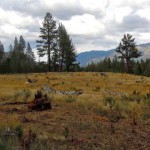Opinion: Washoe Meadows advocates making progress
By Nancy Graalman
A growing coalition of statewide and Lake Tahoe preservation interests, intensifying voices from environmental scientists and economists, and – significantly – a recent court ruling are merging to heighten skepticism over the position of California’s State Parks Department that the only way to mend the Upper Truckee River is to downgrade South Lake Tahoe’s Washoe Meadows State Park in order to expand the Lake Tahoe Golf Course and embark on a massive mechanical transformation of the river’s course.
It is becoming apparent that the dysfunction within State Parks during the past decade of the restoration project’s conception and promotion calls into question the validity of the process and the promised outcomes. The state Legislature’s emergency intervention within the Parks Department in the summer of 2012; the appointment of a new director; the August 2012 passage of AB1478 and its impact on parks administration; changes in thePark Commission composition; and, the recent introduction of the independent Parks Forward Commission point toward many years of ill-conceived and unrestrained ventures.
This disorder was recognized by Alameda County Superior Court Judge Evelio Grillo last month when he ruled that State Parks and the Park Commission failed to act with accountability and transparency and failed to comply with California’s CEQA laws when the Commission approved the Upper Truckee Restoration Project and Golf Course Reconfiguration Project in October 2011. He found that the Washoe Meadows Community’s November 2011 lawsuit charging substantive mitigation and EIR deficiencies by Parks undoubtedly caused the department’s quick procedural backtrack and the Commission’s January 2012 re-vote on the project. Judge Grillo declared that even a single point in the suit was a “significant issue,” and awarded Washoe Meadows Community a portion of the legal fees for proving State Parks’ violations.
According to Lynne Paulson, leader of the Washoe Meadows Community, “Our second suit is now proceeding to seek full accountability for the EIR’s deficiencies and the horrible precedent set by Parks’ decision to downgrade Washoe Meadows State Park. Such a move to strip a state park of its protected status renders all California parks vulnerable if the land becomes attractive for development or for-profit reasons.”
The nearly 700-acre park – which includes forest woodlands, meadows and world-renowned, rare boglike wetlands called Fens — was purchased by the state in 1984 at a taxpayer cost of more than $11 million in today’s dollars. Its natural resources were guaranteed protection by state statue with added defense through its designation as a state park.
The Washoe Meadows Community leads the campaign to promote an alternative to parks’ plan to expand the golf course east of the Upper Truckee into the heart of Washoe Meadows, but groups such as the Tahoe Area Sierra Club, and its prominent chair Bob Anderson, are also sounding the alarm over the project’s ecological and administrative miscalculations.
In addition, internationally respected scientists in diverse fields voice concerns that the State is ignoring warnings that the vast excavation and earth-moving project (some 300,000 cubic feet of dirt would be required to sculpt new golf holes along the river) and the subsequent course maintenance demands could result in unintended, permanent consequences for Lake Tahoe clarity, the spawning streams and fisheries, and Washoe Meadows’ historic Fens.
The EIR accepted by the state even predicts — but dismisses as “temporary” — 15 to 20 years of increased sediment in the river flow due to construction impact.
The eminent scientist Charles Goldman, emeritus professor at UC Davis, said, “I was one of the scientists in the 1972 TRPA meetings reviewing a development proposal in what is now Washoe Meadows State Park, and I was dismayed then to learn that a golf course was proposed for this sensitive riparian area. Fortunately, reason and outrage at the proposal won the day. Water quality is particularly threatened by a golf course not only because of fertilizers and other chemicals but also because of the necessity for irrigation. I urge today’s agencies to only approve an alternative that protects rather than harms the health of the lake and not approve an alternative which has the potential for so many negative impacts.”
Of the imposition of a golf course into Washoe Meadows, wetlands authority Robert Qualls of the University of Nevada, Reno said, “There will always be risks associated with the application of fertilizer in areas with a high water table such as exists to support the fens, and there is a risk of flushing of nutrients during floods. There would also the loss of the nutrient uptake by the more than 1,600 trees that would be removed for the course. The cumulative effect of numerous piecemeal changes can result in a major impairment of water resources and interfere with the productivity and water quality of aquatic ecosystems.”
State Parks has relied on outdated economic and recreational models that favor for-profit concessionaires in its assertion that only a “traditional” golf course replacement will provide sustained revenue for parks, its Lake Valley Recreation Area, and the surrounding South Lake Tahoe region. Conversely, Washoe Meadows Community and its allies – highlighted by the leadership of El Dorado County Supervisor Norma Santiago – have advanced innovative alternatives developed by independent specialists that reflect contemporary conservation practices and future financial and social trends.
The coalition’s intent remains to work with State Parks to restore the Upper Truckee, preserve Washoe Meadows as defined by statute, and propel South Lake Tahoe’s future as a sport and recreation destination for all Californians.
Nancy Graalman is director of Defense of Place.
